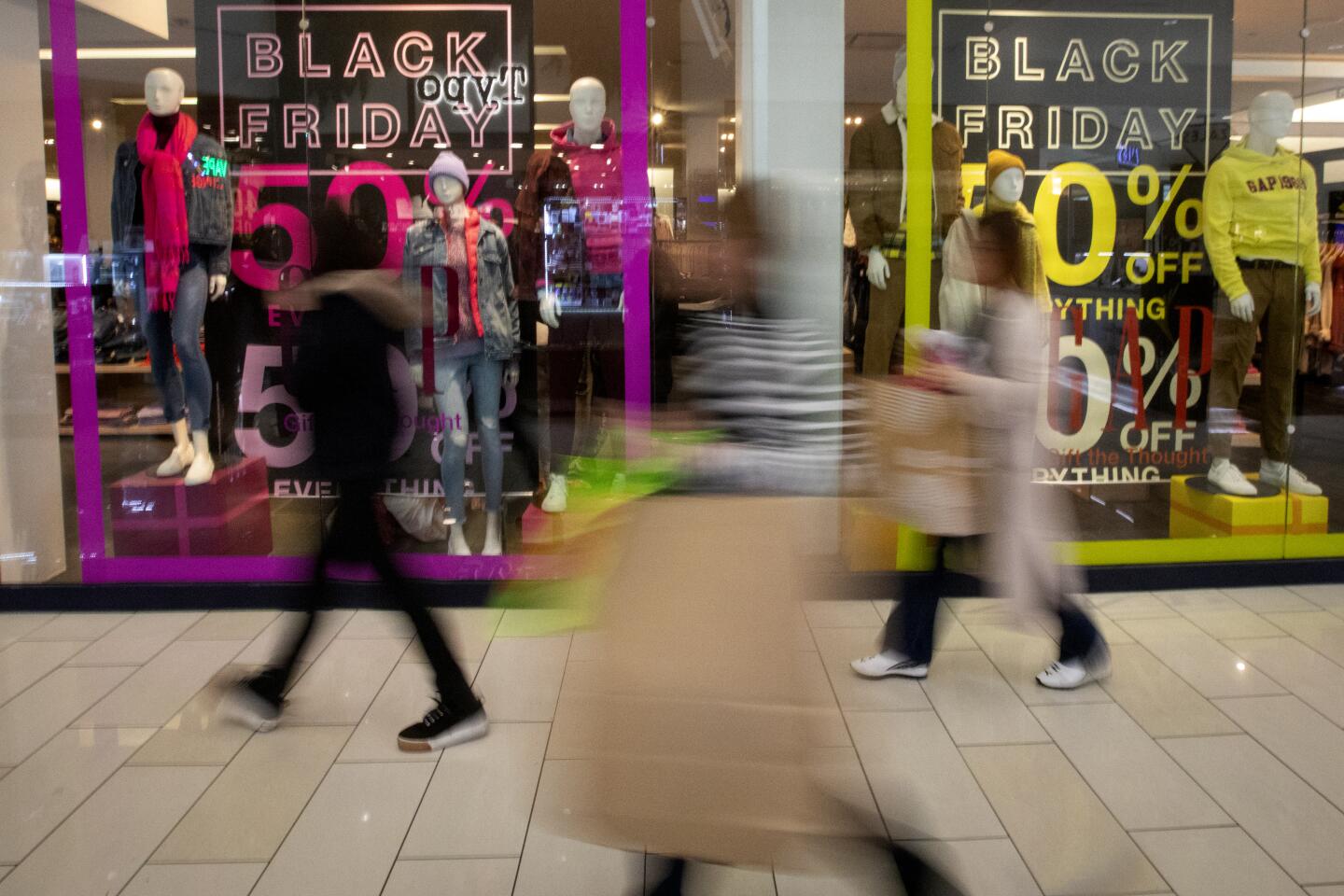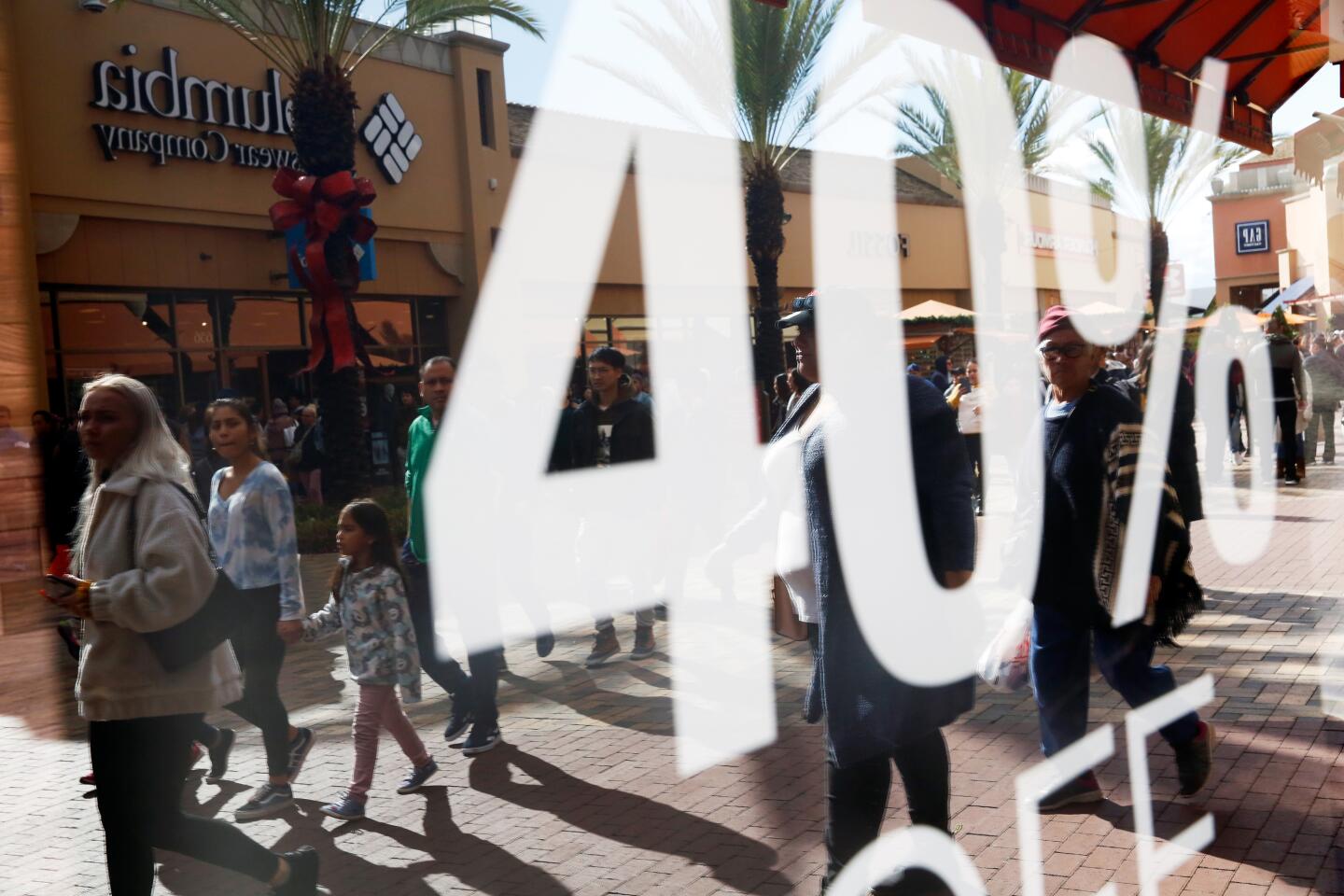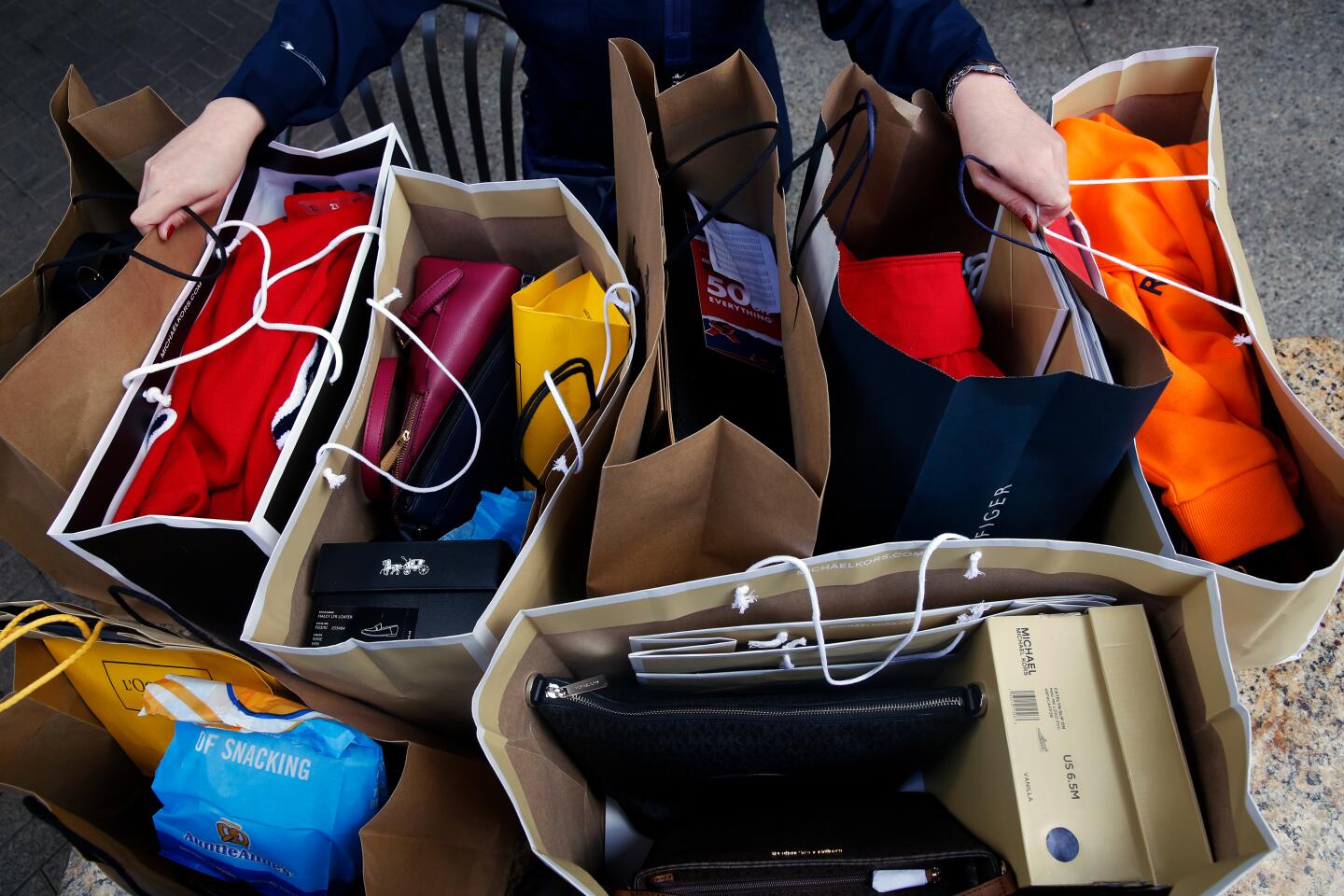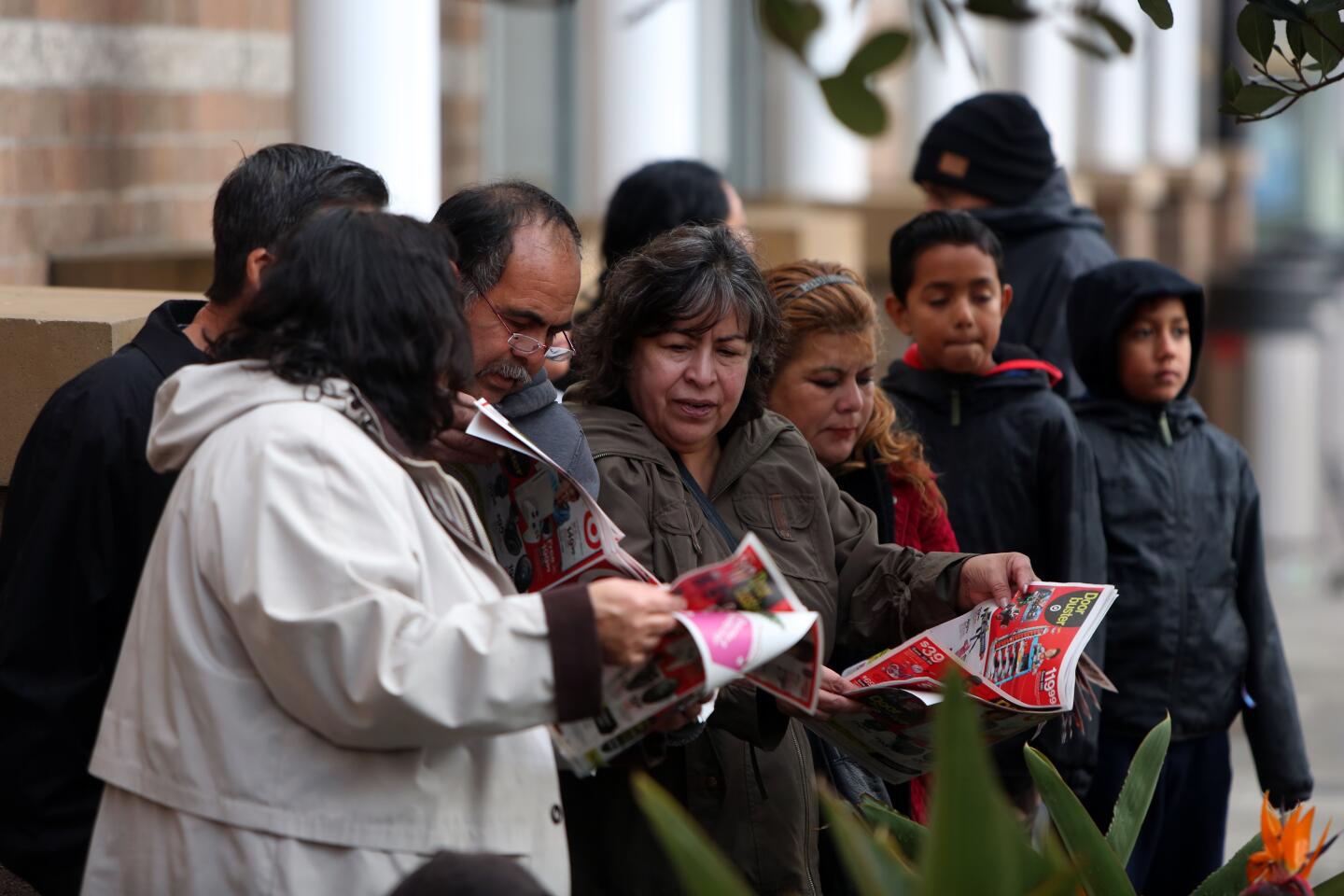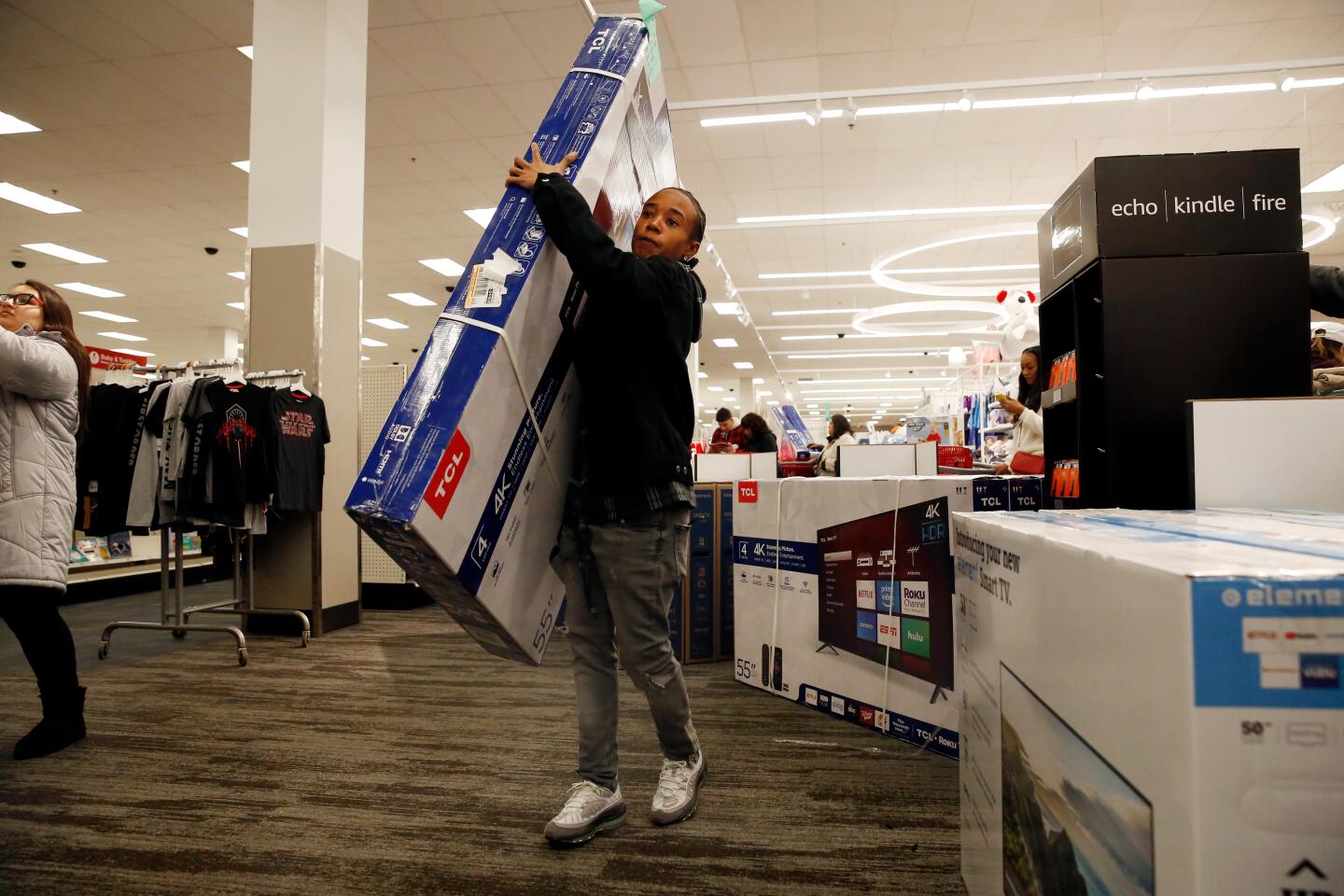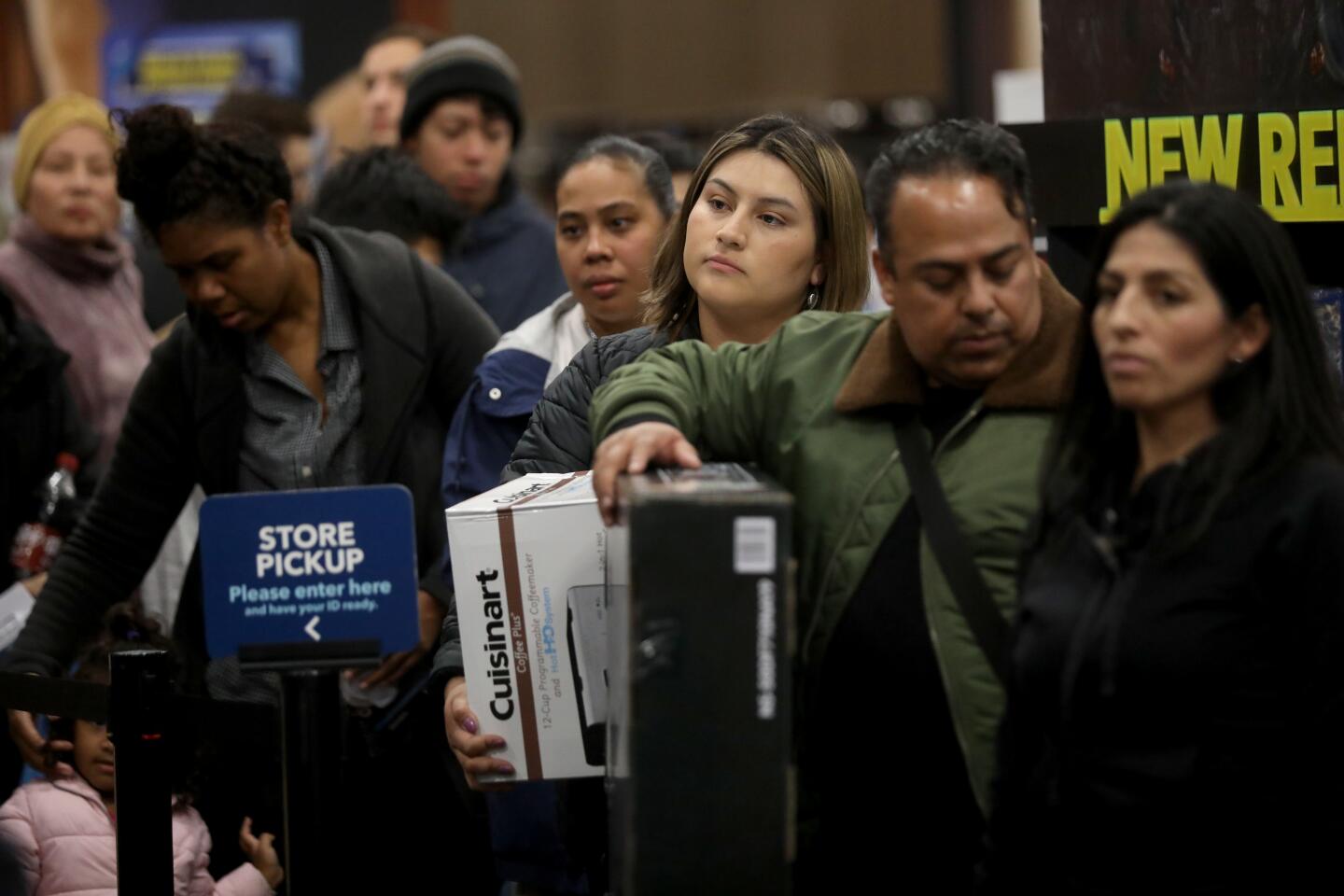Black Friday shoppers have an important job: Fuel the economy
- Share via
Dressed in a magenta track suit, 21-year-old Long Beach resident Maria Viguerias waited on the curb with her little brother.
The two had been shopping at Citadel Outlets since 6:30 a.m. Friday — and they had 12 shopping bags to prove it. Their mother was still at it, contending with winding lines to get into the outlet mall’s most popular stores, and more lines to pay for their products.
Viguerias took care of all her Christmas shopping this Black Friday. “Now I can just relax,” she said. But what most delights her is the present she bought for herself: two pairs of Ugg boots.
“Normally,” Viguerias said, smiling, “they cost $150 per pair, but since they were 50% off, I bought myself two.”
Legions of shoppers like Viguerias are at the top of every retailer’s holiday wish list.
Black Friday’s significance as the bellwether of the holiday shopping season has waned in recent years, as more shoppers take their holiday dollars to online retailers and bricks-and-mortar stores stretch out sales and promotions over the weeks surrounding Thanksgiving. But the season is still crucial for American retailers, and in turn the entire U.S. economy.
Sales over the final few months of the year can account for up to 40% of retailers’ annual revenue, and consumer spending on goods accounts for more than 20% of the nation’s economic activity.
Despite record low unemployment and resulting wage growth over the course of 2019, many Americans are worriedly scanning the horizon for signs of a recession. As a result, some believe that total spending could slip this year, which runs the risk of tripping up the economy as a whole.
More than a third of Americans believe the U.S. is headed toward a recession, according to a survey conducted by the Harris Poll for NerdWallet, and a little less than a third say they’ll be spending less this year as a result. Consumer confidence, as reported by the Conference Board, has fallen for four months in a row, and a survey by Deloitte found that 44% of respondents see the economy weakening in the coming year, up from 37% in 2018.
But shopping so far this year has been strong.
Online shoppers had already spent $57.2 billion from Nov. 1 to Thanksgiving Day, according to Adobe Analytics, up 15% from the same period in 2018. On Thanksgiving itself, shoppers spent a record $4.2 billion on e-commerce — with almost half of those purchases happening on smartphones — and are forecast to spend an additional $7.5 billion on Black Friday, and $9 billion more on Cyber Monday.
This year, the holiday shopping season is six days shorter than in 2018. That means customers will have less time to find what they need, and merchants will have less time to get them in the doors.
Even as e-commerce grows from year to year, shoppers still prefer to spend most of their money at bricks-and-mortar stores. The National Retail Foundation predicts that total holiday spending could hit $730 billion this year, with more than three-quarters of that shopping taking place at stores.
Why? Shoppers — even those who work for e-commerce giant Amazon — like seeing what they buy before they buy it, and knowing that they have it on hand instead of waiting for a package to make it to their homes.
Mario Ruiz, who works as an associate driver for Amazon, and his three friends were the first to arrive at Best Buy in Atwater Village for this year’s Black Friday event.
It’s become a tradition for Ruiz, 21, who remembers visiting Best Buy with his family during his childhood. Now, he camps with his friends to snag the door buster deals before they’re gone.
“We got here at 4:30 am and we were the first ones in line, but it was still dark and really cold,” Ruiz said.
Ruiz planned to buy two Instax film cameras as Christmas presents and a TV for himself. Then he impulse-purchased a $199 PlayStation 4 set that knocked $100 off the console and included a controller and three games that normally sell for $60 apiece, he said.
Even as the novelty wears off from Black Friday, Ruiz said, he prefers shopping in person rather than online.
“I like picking stuff up,” he said. “Sometimes you don’t know if packages are dropped off or they’re stolen.”
Younger shoppers like Ruiz and Viguerias make up the bulk of in-store Black Friday shoppers, according to Brent Schoenbaum, a partner at Deloitte, and L.A. tends to draw a higher proportion of bricks-and-mortar shoppers compared with parts of the country with harsher late November weather.
“Those that seem to be out in greatest volume are really your Gen Z and millennials,” Schoenbaum said, noting that the under-40 crowd treats shopping as a social activity to do with friends. “Those demographics spend a little less than your Gen X, which accounts for the bulk of spending, but they create more traffic in stores.”
For some, snagging deals in person is worth a bit of work.
Two shoppers from Hawaii were spending their L.A. vacation crisscrossing the region in search of sales. Angela and Jayme Bolan, 51 and 49, estimated that the Walmart in Pico Rivera was the 15th store they had visited on their shopping marathon, after starting their Black Friday at the Camarillo outlets Thursday night and then hitting the Citadel twice.
“We haven’t really thought about a budget,” Jayme said. “It’s more like, what can we bring home?”
They came with two suitcases, but can check six suitcases without paying extra, Jayme said. They usually fill all six.
On the other side of town, Westfield Century City was trying a new tactic to lure shoppers who might otherwise just order from the comfort of their screens: a sprawling Christmas village, complete with hot chocolate and food stations, a life-size steam engine replica and a photo station with Santa and Mrs. Claus.
Brent Ramos, 22, woke up at 6.a.m. to leave his home in Watts and go shopping across Los Angeles. After dropping his father off at work, he drove to Westfield Century City to see what it had to offer.
Ramos made the trek to Century City specifically for the mall’s higher-end stores. As he exited the Apple Store, he said he didn’t want to spend too much, but wasn’t afraid to buy what he wanted — especially new clothes.
“I don’t want to get into debt,” Ramos said. “I’m only going to spend what I know I can make back.”
Another new tactic for attracting holiday dollars was on display at the Target at the South Bay Pavilion in Carson. At 5 p.m. on Thanksgiving, a man in a Santa suit rode through the parking lot in a sleigh pulled by two reindeer, with Bullseye, the Target mascot dog, at his side. The stunt was meant to advertise the new drive-up service at the big-box retailer, which lets customers order online and pick up their products curbside.
Also known by the acronym BOPIS (“buy online, pick up in-store”), this hybrid of digital and physical retail has been gaining traction this year, according to Adobe Digital Insights manager Vivek Pandya.
“BOPIS has been a strong sales driver; we’ve been seeing 40% growth there” compared with 2018, Pandya said. “We’re expecting impulse buyers to ratchet that number up,” he added, since the option for immediate pickup could save the day for last-minute shoppers.
But if the deals aren’t good, even an army of promotional Santas won’t be able to make cost-conscious consumers reach for their wallets.
Elsewhere in the Carson mall, a man with a diamond earring and a gray fedora sat alone in front of Daniel’s Jewelers waiting for his wife to finish shopping. William Johnson, 66, said he had been unimpressed with the deals stores are offering.
“They’re not giving a discount on hot commodities,” the South L.A. resident said.
He was hoping to find a Nintendo Switch for his granddaughter, but found that adding in the games she wants would bring the total cost up to $400.
He said he might have to tell her to pick something else as a Christmas present — something a little more affordable.
Times staff writers Erin B. Logan, Jennifer Lu and Emmanuel Morgan contributed to this report.
More to Read
Inside the business of entertainment
The Wide Shot brings you news, analysis and insights on everything from streaming wars to production — and what it all means for the future.
You may occasionally receive promotional content from the Los Angeles Times.

